YAMAHA ZUMA 50 / BWS 50 (CW50, YW50)
First introduced back in 1989 and still on sale as of 2019, the Zuma 50 (aka BWs 50 in Canada) is Yamaha’s widely popular sports scooter.
Over that time the Zuma has gone through two model codes (CW50, YW50), three generations, and a huge number of names (Zuma, Zuma II, Zuma 50F, Zuma 50FX, Zuma X, BWs, BWs 50, BeeWee). The sections below discuss each of these generations.
Generation One: 1989 – 1990, 1997 – 2001
The first generation of Zuma (above) was the ‘non bug eye’ version (model code CW50). With a sporty look and fat tires, the first generation Zuma made it cool to be a scooter rider. It quickly became very popular due to its aggressive styling and 2-stroke motor with substantial performance potential.
The CW50 was first launched in the USA and Canada for 1989 but this initial offering lasted just two years (1989-1990) before taking a hiatus. Yamaha pulled the CW50 from North America after 1990 because of supply shortages caused by its huge popularity in Europe.
Finally in 1995 the CW50 returned to Canada. This model returned to Canada after four years off, but since it wasn’t yet back in the USA, Yamaha opted to save costs sell this scooter in Canada using it’s European name of BeeWee or BW’s (an acronym for “Big Wheel Scooter”). Yamaha did revive the Zuma name in the USA when this scooter returned their for 1997, but by this point the BW’s name was established in Canada and so it has stuck around ever since. In the USA, Yamaha often called the reintroduced CW50 the “Zuma II” but it was mostly the same machine, including the same frame, body panels and motor.
Moreso than any other modern scooter in North America, the CW50 kicked off the aftermarket performance scene. The scooter used a vertical Minarelli motor, for which aftermarket parts were widely available globally and thus a new era of scooter culture was born with countless scooterists installing big bore kits and faster exhaust pipes. These parts are still widely available today, such as from ScooterTuning and ScooterSwapShop.
The CW50 did receive a few updates over its run. For 1990, the Zuma gained a two person seat and footpegs to make carrying a passenger an option. Also at this point, Yamaha shifted production from Japan to a Yamaha owned MBK factory in France. MBK also made a version of this scooter bearing their name called the MBK Booster. When it was reintroduced for it’s final years, Yamaha did release an revised version that was the same core scooter, but with a number of external updates – most notably new rims, a front disc brake (vs drum), and a larger rear rack.
 Generation Two: 2002 – 2005, 2008 – 2011
Generation Two: 2002 – 2005, 2008 – 2011
The YW50 was Yamaha’s replacement for the CW50, and this scooter was introduced for 2002. This model is commonly referred to as the bug eye Zuma, although third generation also shares these lights. This second generation Zuma became extremely popular – even moreso than the CW50 – and is supported by a vibrant online community of enthusiasts. Sales figures are tough to come by, but Yamaha claimed on several occasions that this was the best selling scooter in both Canada and the USA.
With this new generation came a shift in production from the MBK factory in France to a Yamaha factory in Taiwan with far more production capacity. The second generation of Zuma was all new model both mechanically and stylistically. It was sold from 2002 – 2005 and again for 2008 – 2011. The hiatus from 2006-2007 was due to stringent new emissions controls, but it hardly felt like the Zuma was unavailable because Yamaha clogged their showrooms with 2005 models in advance of the legislation. There was hardly a time when you couldn’t find one in your local Yamaha showroom through 2006-2007.
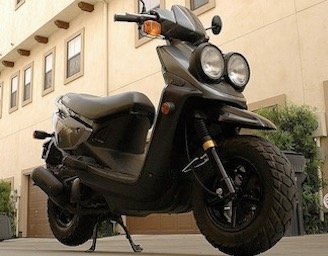
This BWS/Zuma 50cc has many great attributes including its unique and rugged styling, a massive aftermarket scene and its powerful engine. This generation of Zuma used a horizontal Minarelli motor (rather than vertical), for which aftermarket parts are also plentiful. It’s a great scooter for anyone who wants a sporty scooter to modify to go ridiculous speeds. Check out sites like ScooterTuning, ScooterSwapShop and ProvoScooter.com for go-fast goodies.
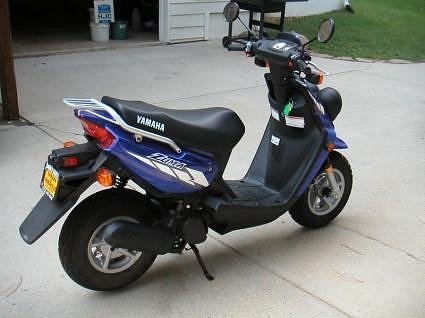
The other downsides of the YW50 are the inherent ones that come with having a 2-stroke engine. A lot of scooters are 2-strokes so it’s not really fair to bring this up, but the YW50 is being sold in a day when most scooters are shifting to 4-stroke engines (The Zuma was the last 2-stroke 50cc from a Japanese manufacturer). Being a 2-stroke, you get great power but you also get reduced fuel economy, increased pollution, you have to buy 2-stroke oil and the engine life is shorter. If you want a 2-stroke scooter you’ve probably already got your mind made up and I can certainly understand why. Read more about 2-stroke vs. 4-stroke engines here.
 Generation Three: 2012 – Present
Generation Three: 2012 – Present
Virtually all new for 2012 (but quite similar looking) is the Zuma 50F. This new Zuma features updated styling and a four stroke motor, which was a shock to tuning enthusiasts. Despite the full overhaul and new engine, Yamaha retained the YW50 model code for this third generation.
With the third generation, the styling is all new but the changes are subtle. Some tweaks were made that increase its stylistic ties to the larger Zuma 125. The bug eye headlights are still present but most other parts are new. This new model has awesome lines on the rear end with a more sculpted and flowing shape that improves upon its already nice predecessor. The red rear shock spring and front caliper are nice touches.
Perhaps as a response to the love it or hate it bug eye headlights, Yamaha released a single headlight version called the Zuma FX (USA) or Zuma X (Canada) for 2014 (below). The Zuma FX has a tidied up front end reminiscent of the Asian spec Zuma 125, which gives it a more mature look. Besides the new light, the Zuma FX adds “race inspired” grips, white rims and a 2-tone paint job. Color options are listed at the bottom of this page. This version remained on sale for 5 years (2014 – 2018).
The 4-stroke motor now powering the Zuma likely won’t be received that well by long time performance enthusiasts who like 2-stroke pep, but it is a great little motor that still has quite good power, advanced technology and excellent fuel economy. It’s a high tech fuel injected, 3 valve, liquid cooled engine which is probably the best 4-stroke 50cc motor in the North American scooter market.
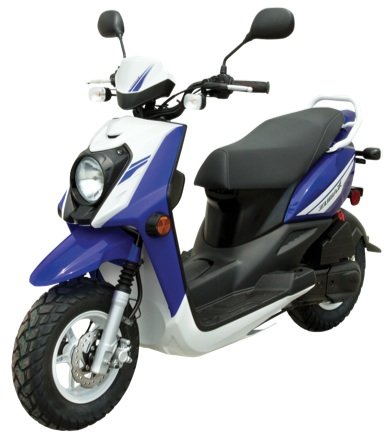
One small change is the trimmed fuel tank which now only holds 1.2 gallons instead of 1.5. While smaller, the 4-stroke engine boasts superior milage, so 4-stroke owners will have similar range as the previous generations despite the smaller tank. Underseat storage has been improved with this new model, which is mostly due to Yamaha’s wise decision to move the gas tank from under the seat to inside the floorboard. This lowers the center of gravity of the scooter and boosts underseat storage, with the downside that a fuel pump is now required. The idea of moving the fuel tank into the floorboard has been seen on other scooters over the past decade or so and its great to see Yamaha adopting this smart design idea. The new generation of YW50 still doesn’t have a glovebox, but a hook now replaces the largely useless ‘gear slot’ found the previous generation.
In the USA, the price rose modestly to $2490 for 2012 and to $2599 for 2013-17. Canadians were asked to pay $3079 in 2012, but the MSRP dropped to $2599 (2013) before rising to $2799 (2017).
Pros:
- Fast (2-stroke models)
- Superb milage (4-stroke model)
- Huge aftermarket for cheap speed (2-stroke models)
- Distinctive and rugged styling
Cons:
- Emissions controls are heavily restrictive (2008, 2011 models)
- Heavy for a 50cc at 205-207lbs
- Bug eye headlights
Links:
’97-’01 CW50 Service Manual – Very helpful for anyone who works on their own scooter
’02 – 2010 YW50 Service Manual – Very helpful for anyone who works on their own scooter
ScooterTuning – Replacement and aftermarket parts for ’89 – 2011 Zuma’s
ScooterSwapShop – Aftermarket goodies for 2-stroke Zuma’s
MotorscooterGuide Forums – Visit the forum on this site to chat about this scoot
2012 Zuma Video Review – Nicely done video by The Scooter Scoop
ZumaForums – Lots of great Zuma talk here
Key Specs (CW50):
- Engine: 2-stroke, air-cooled with fan assist, reed-valve, vertical single
- Displacement: 49 cc
- Bore and Stroke: 40 x 39.2 mm
- Compression Ratio: 7.01 : 1
- Carb: 14mm Dell’orto
- Ignition: CDI
- Suspension (Front): Telescopic fork, 62mm / 2.44″ travel
- Suspension (Rear): Single shock unit swingarm, 60mm / 2.36″ travel
- Brakes (Front): 180 mm disc (drum in ’89-’90)
- Brakes (Rear): Drum
- Tires (Front): 120/90-10
- Tires (Rear): 130/90-10
- Length: 68.5″ / 1740mm
- Width: 26.2″ / 686mm
- Height: 41.3″ / 1050mm
- Wheelbase: 46.0″ / 1170mm
- Seat Height: 29.3″ / 745mm
- Fuel Capacity: 4.6L / 1.2 US Gallons
- Engine Oil: 1.3L / 1.37 US Qts, 10w30
- Wet Weight: 172 lbs / 78kg
- Carrying Capacity 152kg / 355 lbs
Key Specs (2002 – 2011 YW50):
- Engine: 2-stroke, air-cooled with fan assist, reed-valve, horizontal single
- Displacement: 49 cc
- Bore and Stroke: 40 x 39.2 mm
- Compression Ratio: 7.0 : 1
- Maximum Torque: 0.7kg-m(5.1 ft-lb) @ 6,000rpm
- Fuel Delivery: Teikei Y14P Carb
- Ignition: CDI
- Suspension (Front): Telescopic fork
- Suspension (Rear): Single shock unit swingarm
- Brakes (Front): 180 mm disc
- Brakes (Rear): Drum
- Tires (Front): 120/90-10
- Tires (Rear): 130/90-10
- Length: 1,890 mm (74.4 ”)
- Width: 705 mm (27.8 ”)
- Height: 1,110 mm (43.7 ”)
- Wheelbase: 1,275 mm (50.2 ”)
- Seat Height: 765 mm (30.1 ”)
- Fuel Capacity: 5.7 litres (1.2 Imp. gal.)
- Wet Weight: 94kg (206.8lb)
Key Specs (2012-Present YW50 Zuma 50F / FX / X):
- Engine: 4-stroke, 3 valve, liquid cooled, fuel injected 49cc single
- Power: 3 lbs-ft @ 6500 RPM
- Bore and Stroke: 38.0 x 43.6 mm
- Compression Ratio: 12.0 : 1
- Maximum Torque:
- Fuel Delivery: Fuel injection with 19mm Mikuni throttle body
- Claimed milage: 132 mpg
- Ignition: DC CDI
- Suspension (Front): Telescopic fork (2.3”)
- Suspension (Rear): Single shock unit swingarm (2.2”)
- Brakes (Front): 180 mm disc
- Brakes (Rear): Drum
- Tires (Front): 120/90-10
- Tires (Rear): 120/90-10
- Length: 73”
- Width: 28.7”
- Height: 43.1”
- Wheelbase: 50.3”
- Seat Height: 30.7”
- Fuel Capacity: 1.2 gallon (4.5 L)
- Wet Weight: 205 lbs
Colors (USA & Canada):
- 1989: Silky White, Faraway Blue, Composed Red
- 1990: Mature Red, Solid Endura Blue, Black
- 1997: Yamaha Black, Aqua aka Dull Cyan Metallic
- 1998: Yamaha Black, Purplish Blue Candy
- 1999: Yamaha Black, Vivid Red Candy
- 2000: Yamaha Black, Vivid Red Candy. Deep Purplish Blue
- 2001: Vivid Red Candy. Deep Purplish Blue aka Team Yamaha Blue
- 2002: Deep Purplish Blue, Black
- 2003: Deep Purplish Blue, Fairy Silver, Yellow
- 2004: Deep Purplish Blue, Silver 3, Red
- 2005: Deep Purplish Blue, Black
- 2008: Deep Purplish Blue, Black
- 2009 Yamaha Blue, Metallic Black aka Raven, Vivid Yellow (Canada), Vivid Orange (Canada)
- 2010: Raven, Vivid Yellow, Metalllic White (Canada)
- 2011: Team Yamaha Blue/White (USA Only)
- 2012: Raven (aka Metallic Black), Team Yamaha Blue, Alpine White (aka Metallic White)
- 2013: Matte Black, Heat Red, Yamaha Blue (Canada Only)
- 2014 Zuma F / BWS: Matte Titan (Black), Burnt Orange Metallic (USA Only), Vivid Metallic Yellowish Red (Canada).
- 2014 Zuma FX / X: Blue/White, Yellow/Raven (USA Only)
- 2015 Zuma F / BWS: Dark Metallic Green, Matte Titan
- 2015 Zuma FX / X: Team Yamaha Blue & White, Alpine White & Heat Red
- 2016 Zuma F / BWS: Raven (aka Metallic Black in Canada), Vanilla White (USA), Light Yellowish Gray (Canada)
- 2016 Zuma FX / X: Stardust Silver, Radical White
- 2017-2018: Zuma F / BWS: Midnight Silver, Raspberry Red (aka Metallic Red in Canada)
- 2017-2018: Zuma FX / Zuma X: Heat Red, Quick Silver (aka Light Metallic Grey in Canada)
- 2019 Zuma F / BWS: Midnight Silver, Metallic Red/Raspberry

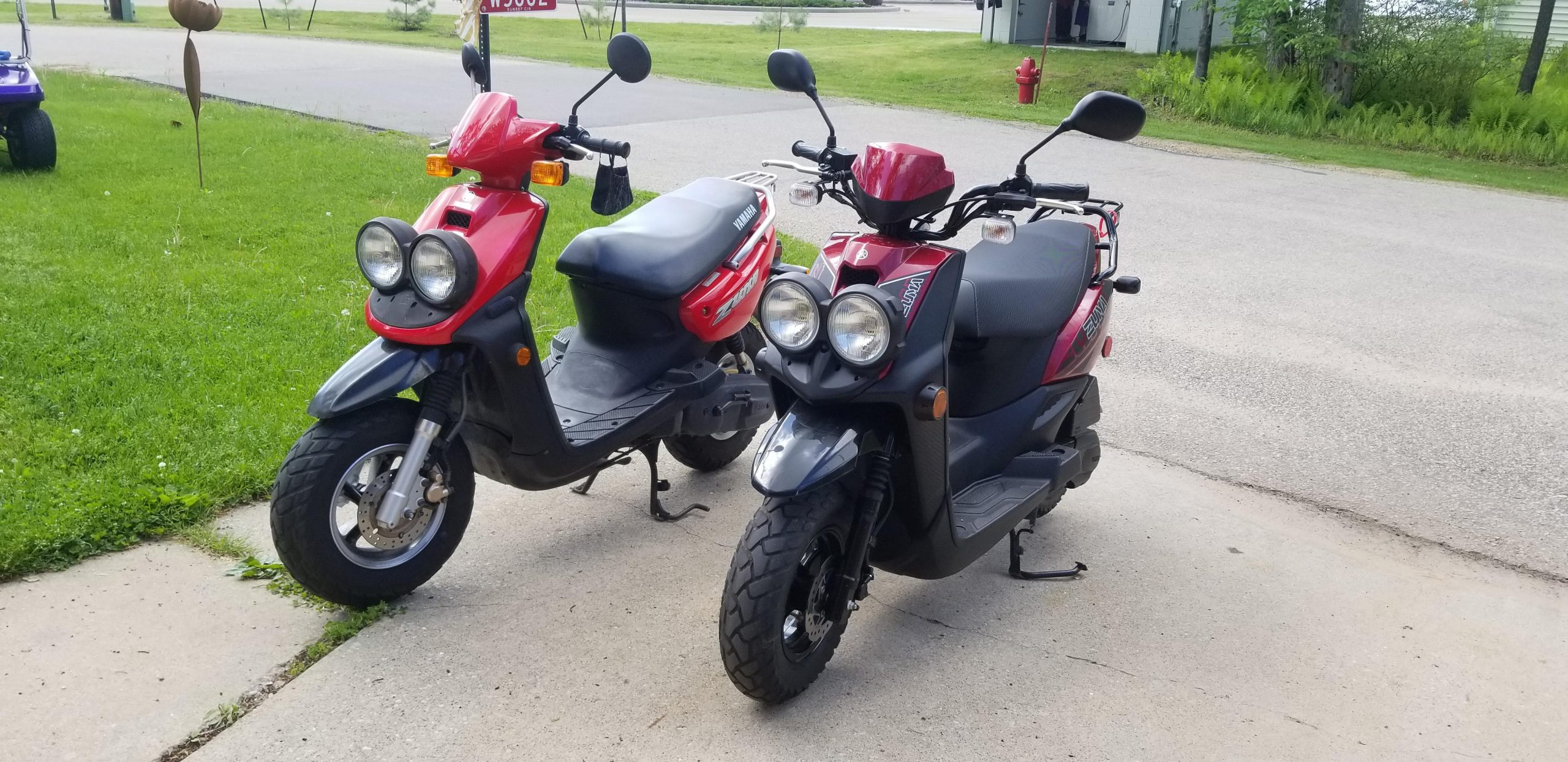
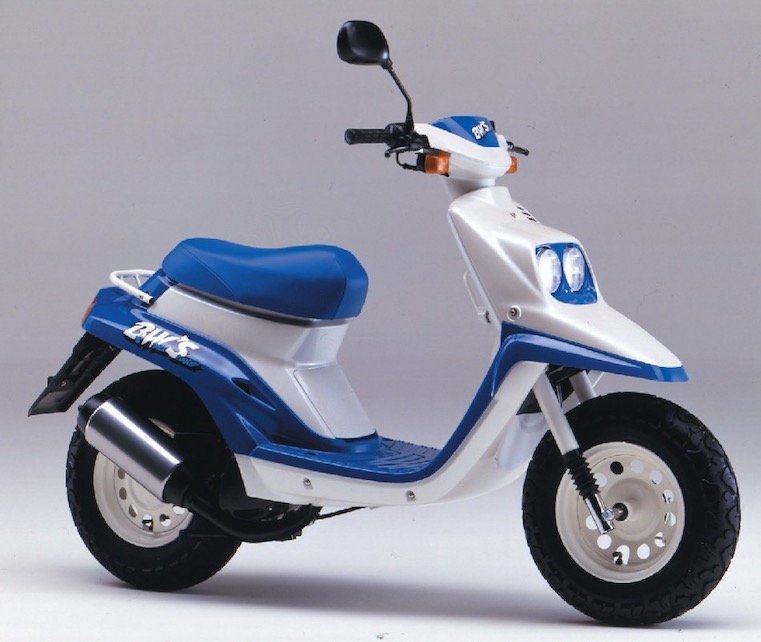
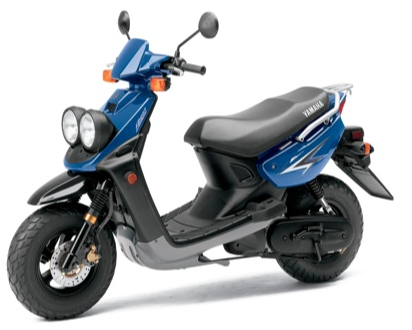 Generation Two: 2002 – 2005, 2008 – 2011
Generation Two: 2002 – 2005, 2008 – 2011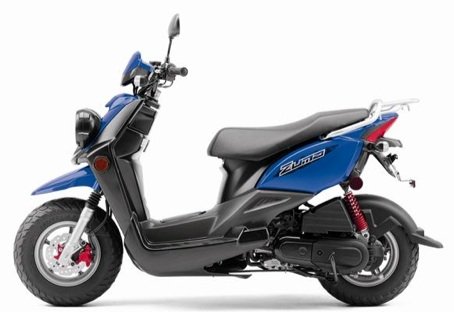 Generation Three: 2012 – Present
Generation Three: 2012 – Present